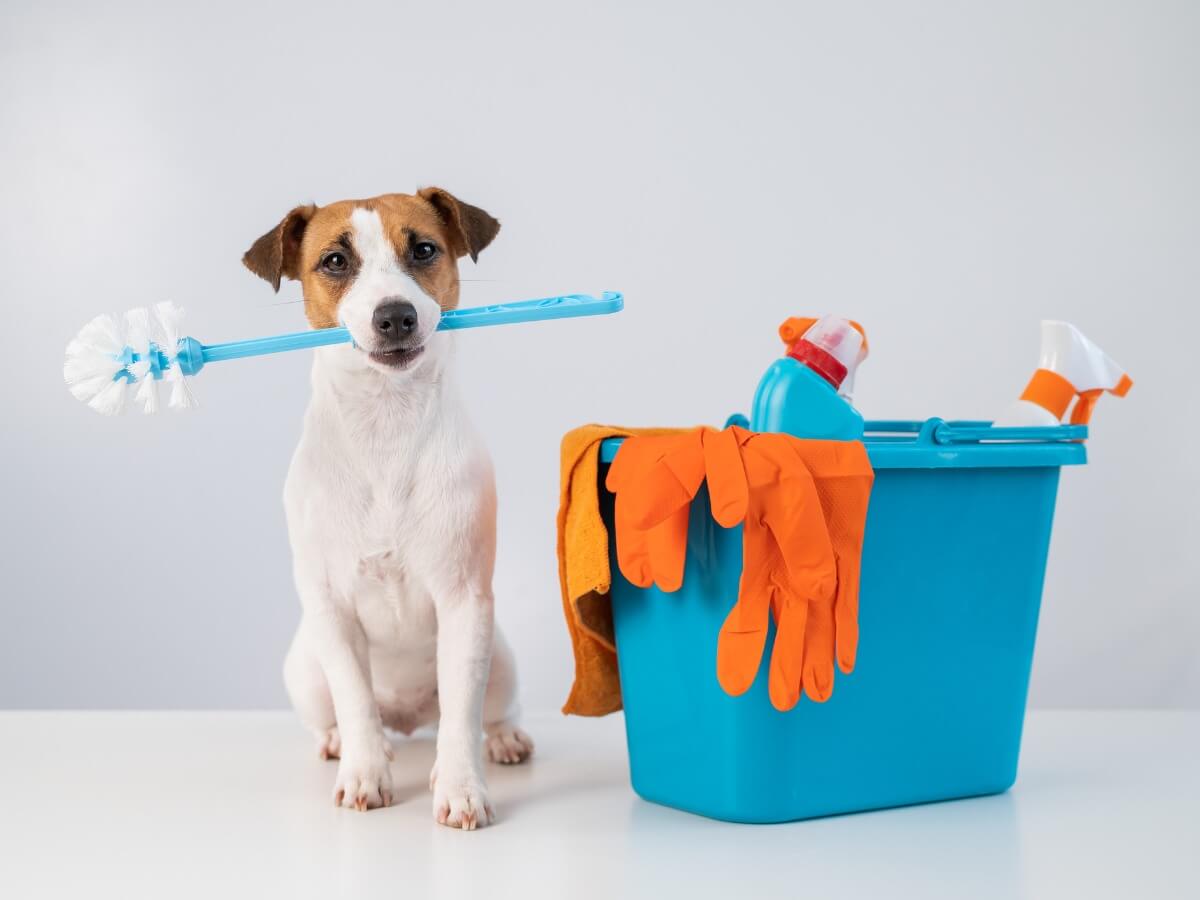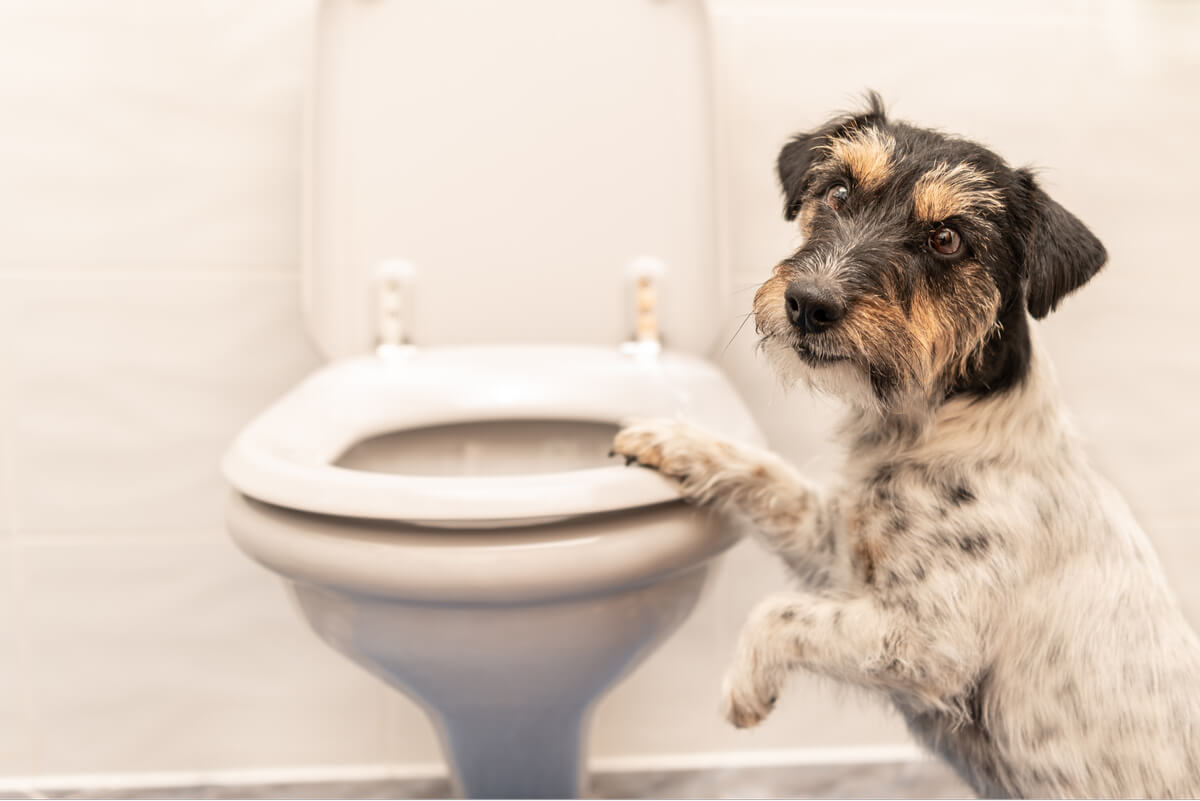Why Does My Dog Follow Me to the Bathroom?


Written and verified by the biologist Samuel Sanchez
Does your dog follow you to the bathroom? Have you wondered why? If so, keep reading. Dogs often have unusual behavior that’s sometimes difficult to explain, and much more so if they’re in a domestic environment without other dogs. As much as they have become accustomed to life in a closed environment, their genetic imprint continues to dictate certain seemingly unfounded behavior.
However, there are many erroneous preconceptions regarding the hierarchical behavior of this species. The wolf (Canis lupus) and the domestic dog (Canis lupus familiaris or Canis familiaris) have a clear sense of organization and this can sometimes explain their way of acting, but not always. If you want to find out more about the subject, you’re in the right place.
Why does my dog follow me to the bathroom?
The first few times your dog follows you to the bathroom may seem like rather adorable behavior. After all, the animal is trying to show you that it wants to be by your side, something that every owner wants to feel when they have a pet. Perceiving that love and appreciation is reciprocated is one of the most beautiful sensations that can be felt when having a dog at home.
However, in the long run, this can become a problem. If your dog follows you around and won’t let you eat, rest, or have privacy when it comes to hygiene, you may feel overwhelmed and rethink what you’re doing wrong. Dogs that can’t keep away from their owners are known as Velcro dogs and their condition can have various causes.
The fact that your pet doesn’t want to be away from you can be something relatively normal or it could turn into an emotional pathological condition. Here are some reasons why your dog may follow you to the bathroom.

The genetic imprint on canine behavior
If your dog follows you to the bathroom sporadically, the most logical thing is to attribute it to herd behavior or pack mentality. As indicated by the National Wildlife Generation, wolves – their direct ancestors – are organized in groups of 15 to 30 individuals and are in constant communication and socialization. As gregarious animals, dogs seek companionship almost continuously.
Training based on hierarchical dynamics assumes that dogs are in a constant “battle” to establish themselves as dominant in the family. If we take for granted that this is the behavior of dogs, it would be easy to think that the pet is “controlling” you or that it is trying to stay ahead of you by following you to the toilet.
Nothing could be further from the truth. According to the VCA Hospitals portal, the alleged canine dominance isn’t based on scientific fact, as not even wolves try to subject members of their pack with challenging or aggressive behaviors. Their role is more paternal than leadership, concepts that have become very confused over time.
So why is your dog following you to the bathroom? The main answer is simple: because they want to make sure that you’re okay. Due to its herd mentality, it accompanies you to ensure you reach your destination safely, not to show dominance or control your actions.
To this day, workouts based on denial of hierarchy are considered unsuccessful, and to some extent, cruel. Dogs don’t seek to dominate other members of the family.
Positive reinforcement
Sometimes, it’s the owner who unconsciously encourages certain behavior in the animal. For example, if your dog follows you and you show them love or give them food each time, then they’ll associate that act with something positive and will be prone to repeat it. This mechanism is a conditioning or positive reinforcement.
Based on this premise, a dog can associate the visit to the bathroom with something positive and accompany you in the process in order to receive its reward. In these scenarios, it’s usually enough if you don’t give react positively to their behavior if you want it to stop. If this doesn’t work, you would need help from a dog trainer.
Curiosity
Dogs have 300 million olfactory receptors in their nasal apparatus, compared to 6 million in humans. This means that they’re capable of smelling 40 times better than us, but their cognitive abilities don’t stop there. Canids can hear sounds up to 65 kHz in frequency, imperceptible to Homo sapiens.
In addition to bringing you a series of curious facts about dogs, we want to emphasize that these animals don’t perceive the world as we do. What is toilet relief to a human, can become a range of smells and perceptions to a canid — as unpleasant as it sounds. Therefore, the reason for the attraction may be sensory stimulation.
The bathroom visit and separation anxiety
The term “separation anxiety” is one of the most feared conditions. If your dog follows you to the bathroom it may be normal, but if they don’t leave your side and show obvious symptoms of dependency, it’s likely that they’re developing an emotional problem.
In order to separate the pathological from the routine, here are some symptoms of separation anxiety in dogs:
- Extreme anxiety when the tutor is going to leave the house. This feeling is channeled in the form of destruction of furniture, crying, uncontrollable urination and defecation, and even self-injury.
- The need for physical contact with the owner. The most dependent dogs are constantly looking for petting and reassurance.
- Following the owner at all times. Whether it’s to the bathroom or any other room, the dog’s continually following its owner can be a sign of separation anxiety.

In short, if your dog follows you to the bathroom, then it’s likely to be simply part of its pack mentality. However, if this behavior is accompanied by other unusual emotional behavior, then it may be separation anxiety. If in doubt, get in touch with an expert.
Does your dog follow you to the bathroom? Have you wondered why? If so, keep reading. Dogs often have unusual behavior that’s sometimes difficult to explain, and much more so if they’re in a domestic environment without other dogs. As much as they have become accustomed to life in a closed environment, their genetic imprint continues to dictate certain seemingly unfounded behavior.
However, there are many erroneous preconceptions regarding the hierarchical behavior of this species. The wolf (Canis lupus) and the domestic dog (Canis lupus familiaris or Canis familiaris) have a clear sense of organization and this can sometimes explain their way of acting, but not always. If you want to find out more about the subject, you’re in the right place.
Why does my dog follow me to the bathroom?
The first few times your dog follows you to the bathroom may seem like rather adorable behavior. After all, the animal is trying to show you that it wants to be by your side, something that every owner wants to feel when they have a pet. Perceiving that love and appreciation is reciprocated is one of the most beautiful sensations that can be felt when having a dog at home.
However, in the long run, this can become a problem. If your dog follows you around and won’t let you eat, rest, or have privacy when it comes to hygiene, you may feel overwhelmed and rethink what you’re doing wrong. Dogs that can’t keep away from their owners are known as Velcro dogs and their condition can have various causes.
The fact that your pet doesn’t want to be away from you can be something relatively normal or it could turn into an emotional pathological condition. Here are some reasons why your dog may follow you to the bathroom.

The genetic imprint on canine behavior
If your dog follows you to the bathroom sporadically, the most logical thing is to attribute it to herd behavior or pack mentality. As indicated by the National Wildlife Generation, wolves – their direct ancestors – are organized in groups of 15 to 30 individuals and are in constant communication and socialization. As gregarious animals, dogs seek companionship almost continuously.
Training based on hierarchical dynamics assumes that dogs are in a constant “battle” to establish themselves as dominant in the family. If we take for granted that this is the behavior of dogs, it would be easy to think that the pet is “controlling” you or that it is trying to stay ahead of you by following you to the toilet.
Nothing could be further from the truth. According to the VCA Hospitals portal, the alleged canine dominance isn’t based on scientific fact, as not even wolves try to subject members of their pack with challenging or aggressive behaviors. Their role is more paternal than leadership, concepts that have become very confused over time.
So why is your dog following you to the bathroom? The main answer is simple: because they want to make sure that you’re okay. Due to its herd mentality, it accompanies you to ensure you reach your destination safely, not to show dominance or control your actions.
To this day, workouts based on denial of hierarchy are considered unsuccessful, and to some extent, cruel. Dogs don’t seek to dominate other members of the family.
Positive reinforcement
Sometimes, it’s the owner who unconsciously encourages certain behavior in the animal. For example, if your dog follows you and you show them love or give them food each time, then they’ll associate that act with something positive and will be prone to repeat it. This mechanism is a conditioning or positive reinforcement.
Based on this premise, a dog can associate the visit to the bathroom with something positive and accompany you in the process in order to receive its reward. In these scenarios, it’s usually enough if you don’t give react positively to their behavior if you want it to stop. If this doesn’t work, you would need help from a dog trainer.
Curiosity
Dogs have 300 million olfactory receptors in their nasal apparatus, compared to 6 million in humans. This means that they’re capable of smelling 40 times better than us, but their cognitive abilities don’t stop there. Canids can hear sounds up to 65 kHz in frequency, imperceptible to Homo sapiens.
In addition to bringing you a series of curious facts about dogs, we want to emphasize that these animals don’t perceive the world as we do. What is toilet relief to a human, can become a range of smells and perceptions to a canid — as unpleasant as it sounds. Therefore, the reason for the attraction may be sensory stimulation.
The bathroom visit and separation anxiety
The term “separation anxiety” is one of the most feared conditions. If your dog follows you to the bathroom it may be normal, but if they don’t leave your side and show obvious symptoms of dependency, it’s likely that they’re developing an emotional problem.
In order to separate the pathological from the routine, here are some symptoms of separation anxiety in dogs:
- Extreme anxiety when the tutor is going to leave the house. This feeling is channeled in the form of destruction of furniture, crying, uncontrollable urination and defecation, and even self-injury.
- The need for physical contact with the owner. The most dependent dogs are constantly looking for petting and reassurance.
- Following the owner at all times. Whether it’s to the bathroom or any other room, the dog’s continually following its owner can be a sign of separation anxiety.

In short, if your dog follows you to the bathroom, then it’s likely to be simply part of its pack mentality. However, if this behavior is accompanied by other unusual emotional behavior, then it may be separation anxiety. If in doubt, get in touch with an expert.
All cited sources were thoroughly reviewed by our team to ensure their quality, reliability, currency, and validity. The bibliography of this article was considered reliable and of academic or scientific accuracy.
- Behavioral problems in dogs, MSD Manuals. Recogido a 5 de julio en https://www.msdvetmanual.com/behavior/normal-social-behavior-and-behavioral-problems-of-domestic-animals/behavioral-problems-of-dogs
- Separation Anxity in dogs, VCA Hospitals. Recogido a 5 de julio en https://vcahospitals.com/know-your-pet/separation-anxiety-in-dogs
- McCrave, E. A. (1991). Diagnostic criteria for separation anxiety in the dog. Veterinary Clinics of North America: Small Animal Practice, 21(2), 247-255.
- Mundell, P., Liu, S., Guérin, N. A., & Berger, J. M. (2020). An automated behavior-shaping intervention reduces signs of separation anxiety–related distress in a mixed-breed dog. Journal of Veterinary Behavior, 37, 71-75.
- Yohe, M. (2021). Predictors of Separation Anxiety in Dogs.
This text is provided for informational purposes only and does not replace consultation with a professional. If in doubt, consult your specialist.








